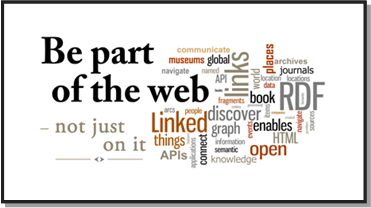in support of
Stanford Linked Data Workshop
June 27 — July 1, 2011
[ final report ]

Foreword
Linked data holds tantalizing promise for cultural heritage institutions as a means for crowdsourcing and enhancing the multifaceted cultural metadata that drives their enterprise. For libraries, archives, and museums, linked data holds the potential to move our collections out of their silos, to leverage the knowledge capital represented by our collections, and to enrich our information landscape. But what is “linked data,” and how is it different from “linked open data”? How can cultural heritage institutions use and publish it? How does it go from concept to practice? It becomes clear, very quickly, that linked data is a complex, interwoven concept that often confuses more than guides us in the pursuit of enhanced metadata management. **
This year momentum has reach a critical threshold around the idea of using linked data in libraries, archives, and museums. The W3C Library Linked Data incubator group published its draft report with use cases and data sets. The Alfred P. Sloan Foundation funded a LOD-LAM meeting to bring together practitioners and seed conversations about practical applications of linked data in libraries. This effort has spawned a series of regional meetings in Washington DC, New Zealand, and New York City that continue the dialog. Linked data interest groups are cropping up (LITA/ACRL) and presentations featuring linked data have been prominently featured at many conferences.
At CLIR, we have responded to the communities’ curiosity about linked data by creating a DLF Community Linked Open Data special interest group. Additionally, with generous funding from The Andrew W. Mellon Foundation, CLIR partnered with Stanford University on a project to advance the library linked data conversation. The project consisted of a workshop, hosted by Stanford in July 2011, and two publications. The first, a literature survey on linked data, was distributed to participants before the workshop as a means of informing discussion. CLIR commissioned Jerry Persons to conduct the survey, which is provided here. The second publication, a report on the workshop itself, was prepared by Stanford and is available here.
The linked data survey that follows guides us through the multifaceted realm of linked data and its various concept threads. It exposes a range of perspectives on the topic, identifies leading voices, and highlights active areas of linked data development and exploration. It is intended to be a primer to our communities, and we hope that it will provide a common basis of understanding or starting point for future work.
The linked data discussion continues to grow, and we at CLIR are focusing our efforts to encourage open dialog and an intentional cross-pollination of ideas. Because this is such a topic of interest, many conversations are happening, in many communities, around the globe. CLIR, through its research, publications, and community-driven DLF program, is striving to connect these conversations and create a shared understanding, in order to move forward and realize the promise of linked data for libraries, archives, and museums.
-Rachel Frick, September 2011
IntroductionPre-workshop statement of objectives
Landscape
WHAT, WHY & HOW
What … in scopeWhat … out of scopeWhy pursue linked dataHow to pursue linked data
STATUSStatus & EnvironsChallenges & OpportunitiesKnowledge management in general
DISCOVER & IDsDiscovery & NavigationIdentifiers
URIs & SCHEMASources of Identifiers and LinksVocabulary & Schema
PROJECTS
Projects, institutions, organizations…
TOOLS
Lists, how to, by functionWorkflowsCrowdsourcing
CHECKLISTS
Acronyms
Agencies and OrganizationsMeetingsVendors
** For a brief description of the use of linked data please see this introductory talk
from Jon Voss at the recent Linked Open Data Regional Meeting in DC:
http://lod-lam.net/summit/2011/09/15/intro-to-lodlam-talk-live-from-the-smithsonian/.

